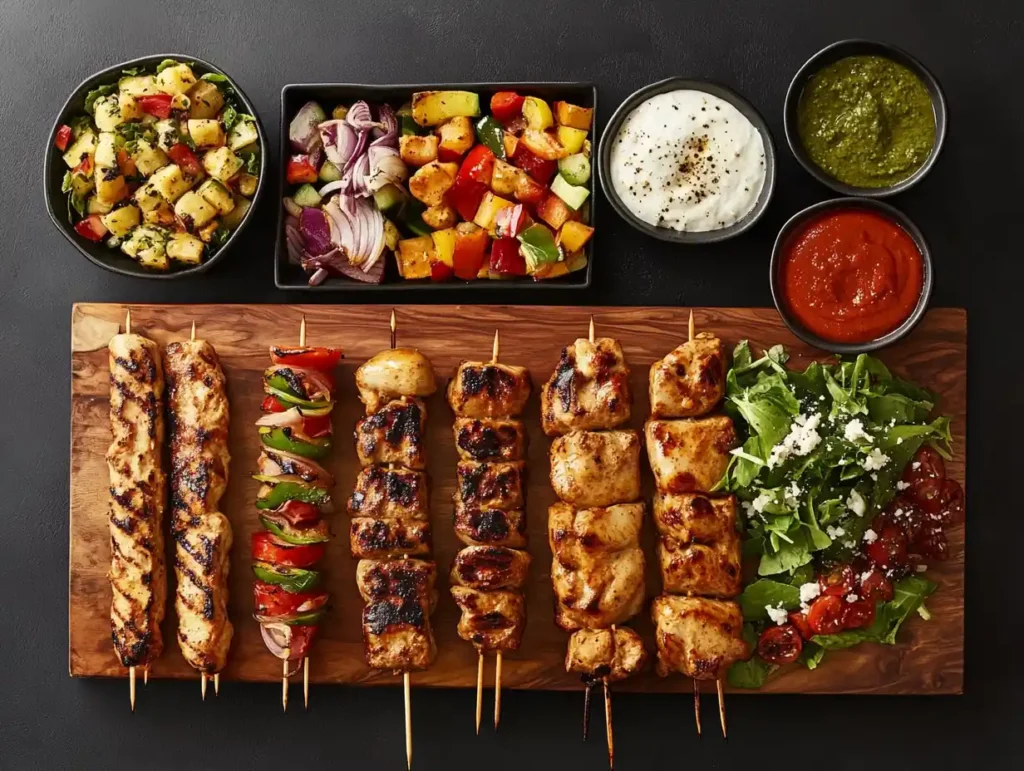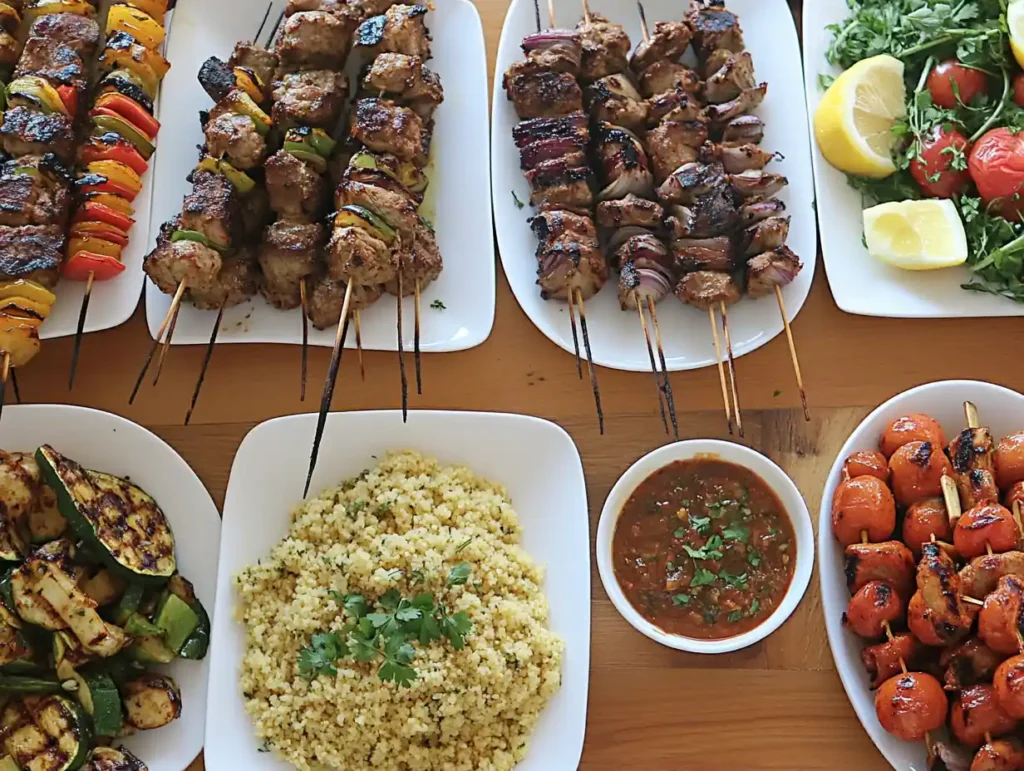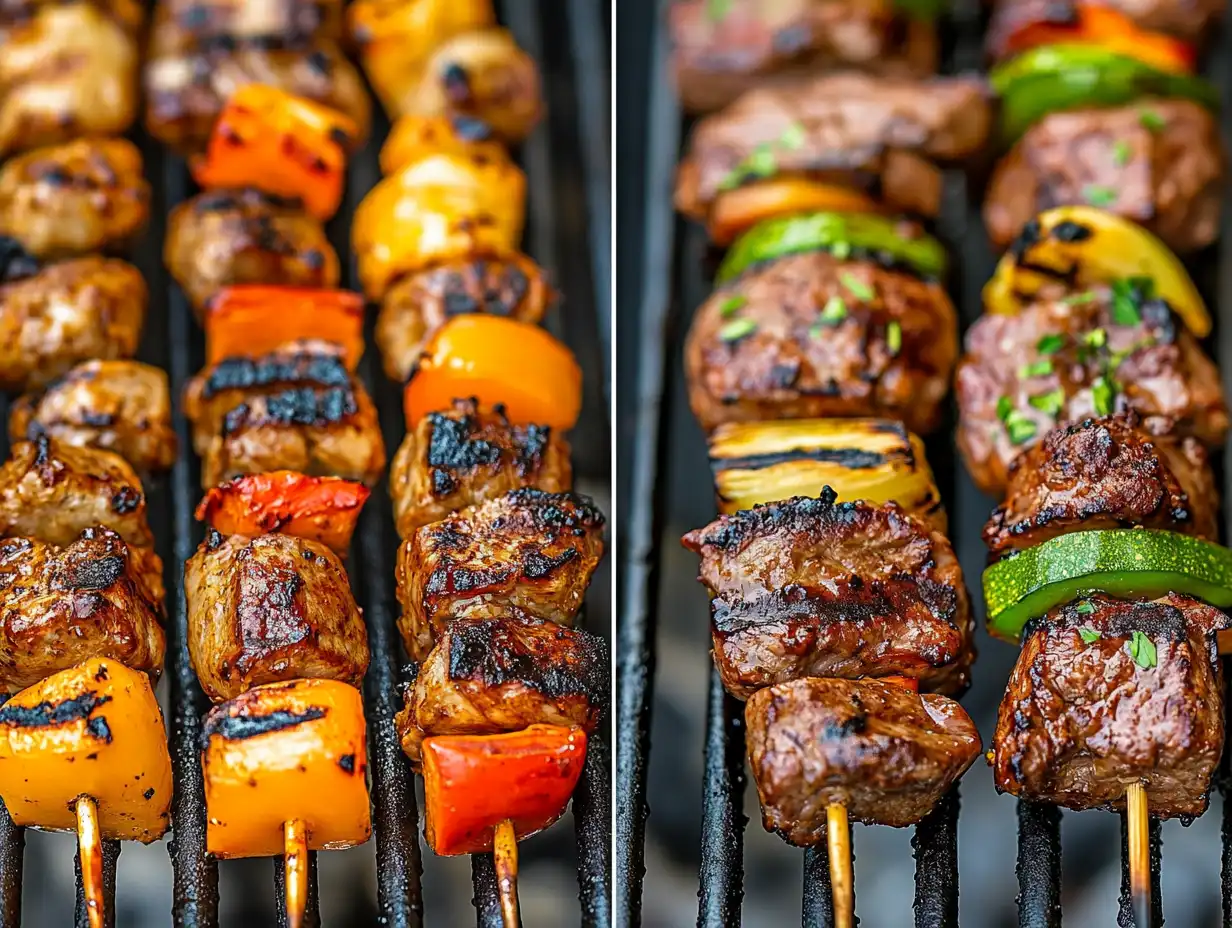Introduction
Skewers and kabobs are popular dishes enjoyed worldwide, especially during barbecues, picnics, and festive gatherings. Both involve threading pieces of food onto sticks, making them visually appealing and easy to serve. However, many people wonder—what is the difference between skewers and kabobs?
While the terms are often used interchangeably, there are key distinctions between the two. Skewers typically refer to the tool or stick used to hold ingredients, while kabobs describe the dish itself, which is often prepared with seasoned meats, vegetables, or fruits and cooked on a grill or open flame.
In this article, we’ll dive into the definitions, differences, and cultural variations of skewers and kabobs. Whether you’re a home cook or a food enthusiast, you’ll discover cooking tips, serving ideas, and preparation techniques to elevate your grilling game.
Defining Skewers and Kabobs
What Are Skewers?
Skewers refer to the stick or rod used to pierce and hold ingredients like meat, vegetables, or fruits for cooking or serving.
- Material Types – Skewers are made of bamboo, wood, or metal and come in different shapes (flat, round, or double-pronged).
- Purpose – Used for grilling, baking, or roasting, skewers make it easy to flip and cook food evenly over heat.
- Versatility – Skewers can hold a variety of foods, from appetizers and kebabs to fruit platters and dessert treats.
In short, skewers are more about the tool than the dish itself.
What Are Kabobs?
Kabobs (or kebabs) are dishes consisting of skewered and grilled ingredients, often seasoned with spices or marinades.
- Origin – Kabobs have roots in Middle Eastern, Mediterranean, and South Asian cuisines.
- Traditional Preparation – Typically made with marinated meats, such as lamb, chicken, or beef, and sometimes vegetables or seafood.
- Variations – Includes styles like shish kabobs, doner kebabs, and satay skewers, depending on regional influences.
While kabobs are always assembled on skewers, not all skewer-based dishes qualify as kabobs.
Key Similarities Between Skewers and Kabobs
- Both involve threading ingredients onto sticks for easy cooking and serving.
- Both can be grilled, roasted, or baked using various marinades and seasonings.
- Both allow for customizable combinations of meats, vegetables, and fruits.
Despite these similarities, the differences in preparation, presentation, and cultural significance set them apart.
Primary Differences Between Skewers and Kabobs
Cooking Style and Preparation
The main difference between skewers and kabobs lies in how they are prepared and cooked.
- Skewers – Focus on the tool itself and can be used for a variety of dishes, including grilled meats, vegetables, fruits, and desserts. Skewers don’t always require marination or seasoning and can even be served cold, such as in fruit skewers or appetizer platters.
- Kabobs – Specifically refer to seasoned or marinated ingredients, often meat-focused and grilled over open flames. Kabobs are usually more complex in flavor because of their marinades and spices, making them a cooked dish rather than just an assembly.
Serving Style and Presentation
- Skewers – Can be single-ingredient or mixed, and are often served as finger foods or decorative appetizers. Skewers might not follow a specific recipe and are more about presentation.
- Kabobs – Served as a main dish, often plated alongside rice, salads, pita bread, or sauces. They follow traditional recipes like shish kabobs and emphasize flavor and seasoning.
Regional and Cultural Differences
- Skewers – Used globally, skewers are common in Western-style BBQs, where meats and vegetables are lightly seasoned or grilled plain.
- Kabobs – Originating from Middle Eastern, Turkish, and South Asian cuisines, kabobs are deeply rooted in cultural traditions and often carry complex marinades and spice blends. Examples include Indian tandoori kebabs and Greek souvlaki.
Types of Skewers and Their Uses

Bamboo Skewers vs. Metal Skewers
- Bamboo Skewers – Affordable and disposable, perfect for casual grilling. However, they need to be soaked in water before use to prevent burning.
- Metal Skewers – Reusable and durable, ideal for high-heat grilling. They retain heat, helping to cook food from the inside out.
Specialty Skewers (Flat, Round, or Double-Pronged)
- Flat Skewers – Prevent ingredients from spinning, ensuring even cooking. Best for meats and firm vegetables.
- Round Skewers – Work well for soft or smaller items, such as shrimp and mushrooms.
- Double-Pronged Skewers – Provide extra stability for heavier ingredients, like steaks or kabobs.
Ideal Ingredients for Skewers
- Proteins – Chicken, beef, pork, shrimp, and tofu.
- Vegetables – Bell peppers, onions, zucchini, cherry tomatoes, and mushrooms.
- Fruits – Pineapple, watermelon, grapes, and strawberries (often served raw).
- Desserts – Marshmallows, brownies, and fruit combinations for sweet skewers.
Popular Types of Kabobs Around the World

Middle Eastern Shish Kabobs
Shish kabobs originate from the Middle East and feature marinated cubes of meat, such as lamb or beef, threaded onto skewers. Cooks often grill them over open flames, giving the meat a charred and smoky flavor. They typically season shish kabobs with garlic, cumin, paprika, and coriander.
Turkish Shish Kebab and Doner Kebab
- Shish Kebab – Chefs marinate chicken, beef, or lamb in spices and grill it on skewers. They usually serve it with pita bread, yogurt, or hummus.
- Doner Kebab – This version involves spit-roasted meat, which chefs slice thinly and serve in flatbreads or wraps. The method delivers tender, flavorful layers of meat.
Asian Satay and Yakitori Kabobs
- Satay (Southeast Asia) – Street vendors grill marinated chicken or beef skewers and serve them with a peanut sauce dip. The marinade includes lemongrass, turmeric, and coconut milk for a bold flavor.
- Yakitori (Japan) – Japanese chefs prepare grilled chicken skewers using teriyaki glaze or soy-based sauces. They cook them over charcoal grills for an authentic smoky taste.
Mediterranean Souvlaki and Gyro Kabobs
- Souvlaki (Greece) – Greek recipes feature grilled pork or chicken skewers, often paired with tzatziki sauce and pita bread.
- Gyro Kabobs – Inspired by rotisserie-style cooking, chefs use thinly sliced meat layered into pita wraps with tomatoes, onions, and sauces.
American BBQ-Style Kabobs
In the U.S., BBQ-style kabobs include a mix of meats and vegetables, such as steak, chicken, onions, and peppers. Home cooks marinate the ingredients in BBQ sauces or honey glazes before grilling them for a sweet and smoky flavor.
Cooking Methods for Skewers and Kabobs
Grilling Over Open Flames
Grilling remains the most popular method for cooking skewers and kabobs. The direct heat imparts a smoky flavor while creating a slightly charred crust on the outside.
- How to Grill Skewers and Kabobs:
- Preheat the grill to medium-high heat.
- Lightly oil the grates to prevent sticking.
- Place skewers directly on the grill and rotate every 2–3 minutes for even cooking.
- Remove when meats reach their internal temperature (e.g., 165°F for chicken).
- Pro Tips:
- Use metal skewers for durability or soak bamboo skewers in water for 30 minutes to avoid burning.
- Place vegetables on separate skewers to prevent overcooking.
Oven-Baked Techniques
Ovens provide an excellent alternative for those without a grill. Baking offers consistent heat and reduces the risk of flare-ups.
- Steps for Baking Kabobs:
- Preheat the oven to 400°F (200°C).
- Arrange skewers on a baking sheet lined with foil or parchment paper.
- Bake for 15–20 minutes, turning halfway through.
- For extra crispiness, broil for 2–3 minutes at the end.
- Why Use This Method?
Baking works well for winter cooking and provides a mess-free option without compromising flavor.
Stovetop Cooking with Grill Pans
Grill pans create grill marks and flavor similar to outdoor grilling but work indoors.
- How to Cook on a Grill Pan:
- Heat the pan over medium-high heat.
- Lightly grease the pan to prevent sticking.
- Cook kabobs for 3–5 minutes per side, turning until all sides are browned.
- Best Ingredients for Stovetop Cooking:
Softer vegetables like zucchini and mushrooms and small cuts of meat cook faster and evenly on grill pans.
Broiling vs. Roasting Methods
Broiling provides direct heat from above, mimicking grilling, while roasting uses indirect heat for more even cooking.
- Broiling Tips:
- Place skewers on a rack near the broiler element.
- Cook for 5–7 minutes per side, flipping once to brown evenly.
- Roasting Tips:
- Cook at 375°F to 400°F for 20–25 minutes, turning once halfway through.
Both methods work well for kabobs with larger pieces of meat or ingredients that need longer cooking times.
Marinades and Seasonings for Skewers and Kabobs
Common Marinades for Meat and Vegetables
Marinades enhance flavor and tenderize meats, making skewers and kabobs more juicy and flavorful. The best marinades often combine acid, oil, and spices for balance.
- Citrus-Based Marinades – Use lemon or lime juice for bright, tangy flavors. Ideal for chicken, seafood, and vegetables.
- Soy Sauce Marinades – Combine soy sauce with garlic, ginger, and sesame oil for an Asian-inspired twist. Perfect for beef, pork, and mushrooms.
- Herb-Infused Marinades – Mix olive oil, oregano, thyme, and rosemary for Mediterranean-style kabobs. Works well with lamb, chicken, and vegetables.
- Spicy Marinades – Add cayenne pepper, paprika, or chili flakes for a fiery kick. Ideal for shrimp and steak.
- Sweet Marinades – Blend honey, brown sugar, or pineapple juice for a sweet glaze. Great for BBQ kabobs and fruit skewers.
Herbs, Spices, and Flavor Combinations
Spices play a vital role in elevating the taste of kabobs and skewers. Here are popular combinations:
- Middle Eastern Style – Cumin, coriander, paprika, garlic, and cinnamon.
- Asian Style – Soy sauce, ginger, sesame seeds, and chili flakes.
- Mediterranean Style – Oregano, rosemary, lemon zest, and garlic.
- BBQ Style – Smoked paprika, black pepper, garlic powder, and cayenne.
Tips for Marinating and Flavor Enhancement
- Marinate for At Least 30 Minutes – Allow meats to absorb flavors. For tougher meats like beef, marinate for 4–6 hours or overnight.
- Use Zip-Lock Bags or Containers – Ensure even coating by sealing ingredients in airtight bags or bowls.
- Don’t Over-Marinate – Avoid marinating seafood or vegetables for too long as acids can break them down and make them mushy.
- Reserve Marinades for Basting – Set aside extra marinade before adding raw meat and use it for basting while grilling.
Serving Suggestions for Skewers and Kabobs

Side Dishes and Dipping Sauces
Pair skewers and kabobs with complementary side dishes and sauces to create a complete meal:
- Side Dishes:
- Rice Pilaf or Couscous – Ideal for Mediterranean kabobs.
- Grilled Vegetables – Adds color and flavor to any dish.
- Salads – Fresh Greek salad, tabbouleh, or coleslaw pairs well with kabobs.
- Flatbreads or Pita – Serves as a base for dipping and stuffing kabobs.
- Dipping Sauces:
- Tzatziki Sauce – Perfect for Greek kabobs.
- Hummus or Baba Ganoush – Complements Mediterranean flavors.
- Peanut Satay Sauce – Ideal for Asian-style skewers.
- Garlic Aioli or Chimichurri – Adds richness and freshness to grilled meats.
Presentation Ideas for Parties and Gatherings
Make skewers and kabobs the centerpiece of your party with creative presentations:
- Vertical Stands – Display kabobs upright on metal stands for a unique look.
- Layered Platters – Arrange skewers in circular patterns on large trays with garnishes.
- Mini Skewers for Appetizers – Create bite-sized skewers for finger foods at cocktail parties.
- Serving Boards with Dips – Place kabobs on wooden boards with bowls of sauces and dips for a rustic feel.
Pairing Suggestions with Wines and Beverages
Pair skewers and kabobs with the right drinks to enhance the dining experience:
- Red Wine – Complements beef and lamb kabobs with bold flavors.
- White Wine – Pairs well with chicken, seafood, and vegetable skewers.
- Cocktails – Margaritas or mojitos add refreshing balance to spicy kabobs.
- Mocktails or Lemonades – Serve fruit-infused waters or lemonades for lighter pairings.
FAQs: What Is the Difference Between Skewers and Kabobs?
Are skewers and kabobs the same thing?
No, they are not the same. Skewers refer to the sticks or rods used to hold and cook food, while kabobs are the actual dishes made by threading marinated meats, vegetables, or fruits onto skewers and cooking them.
Can you make kabobs without skewers?
Yes, kabobs can be cooked without skewers by grilling or roasting ingredients on a grill pan, baking tray, or directly on the grill. However, using skewers makes them easier to handle and adds to their visual appeal.
What are the best materials for skewers?
- Bamboo Skewers: Disposable and inexpensive but must be soaked in water to avoid burning.
- Metal Skewers: Reusable, durable, and great for high-heat grilling. They’re easy to clean and don’t require soaking.
- Flat or Double-Pronged Skewers: Best for heavy ingredients since they prevent slipping or spinning.
Are kabobs always grilled?
No, while grilling is the most common method, kabobs can also be baked, broiled, roasted, or cooked in a grill pan. Some regional variations, like doner kebabs, are roasted on vertical spits.
What vegetables work best for kabobs?
The best vegetables for kabobs include bell peppers, onions, cherry tomatoes, zucchini, mushrooms, and eggplant. These vegetables hold up well to heat and grilling without falling apart.
Can skewers and kabobs be made vegetarian?
Absolutely! Vegetarian kabobs often feature tofu, paneer, mushrooms, and grilled vegetables. Add seasonings, marinades, or sauces to make them flavorful. Fruit skewers also work great for desserts and appetizers.
Conclusion
While skewers and kabobs share similarities, their purpose and preparation methods set them apart. Skewers refer to the sticks used to hold food, while kabobs highlight the dish itself, often rich in flavor and seasoning.
Whether you’re hosting a summer BBQ, preparing quick appetizers, or trying international recipes, both skewers and kabobs offer endless versatility. With the tips provided in this guide, you can confidently select the right ingredients, marinades, and cooking methods to create perfectly cooked and flavorful dishes every time.
So fire up your grill or oven and get creative with your favorite combinations of meats, vegetables, and seasonings. Skewers and kabobs bring fun and flavor to any meal, making them a favorite for both casual dinners and festive celebrations!
Curious about creative skewer recipes? Check out charcuterie skewers for fun and delicious appetizer ideas. If you’re exploring other handheld bites, try pepperoni pinwheels for an easy-to-make snack. For more tips on assembling dishes, learn how to get pinwheels to stay together with simple techniques!

